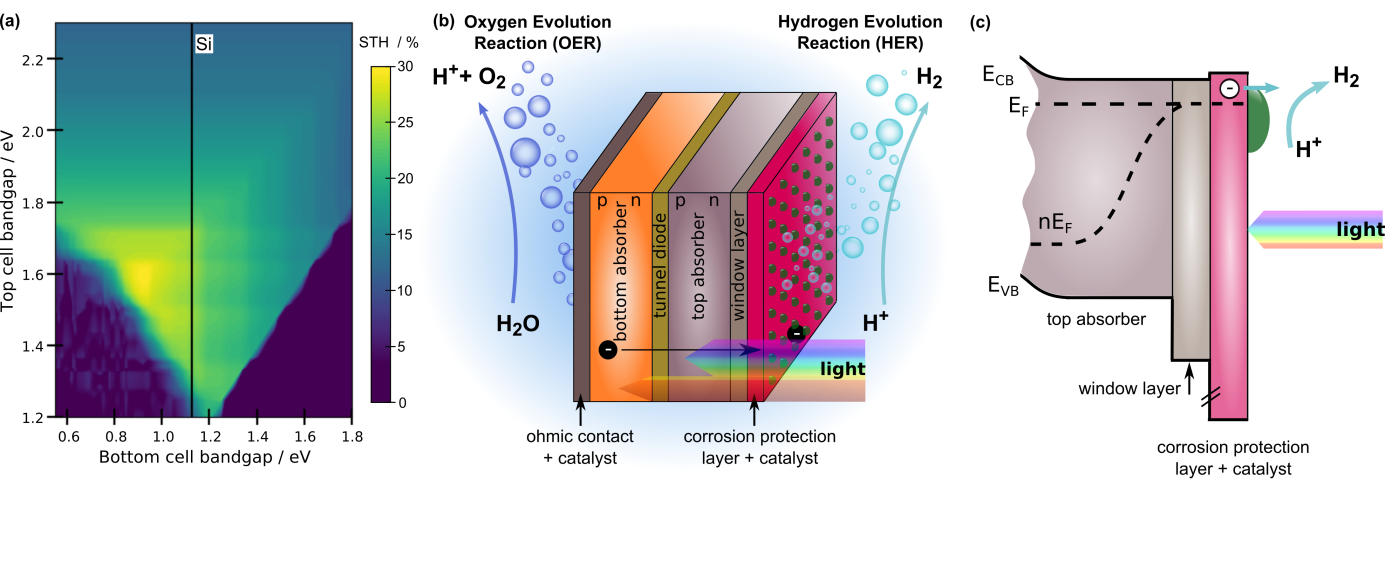Among various types of solar cells, MOVPE-grown triple-junction III-V compound semiconductors are today’s most efficient photovoltaic devices with conversion efficiencies exceeding 40%. A next-generation multijunction cell with four or more junctions and optimized band gaps is expected to break the present record efficiency surpassing the 50% mark. High band gap material combinations that are lattice matched to GaAs are already well established, but the required low band gap combinations containing a band gap around 1eV are still to be improved. For this purpose, we have developed a low band gap tandem (two-junction) solar cell lattice matched to InP. For the top and bottom subcells InGaAsP (Eg = 1.03 eV) and InGaAs (Eg = 0.73 eV) were utilized, respectively. A new interband tunnel junction was used to connect the subcells, including thin and highly doped layers of n-type InGaAs and p-type GaAsSb. The delicate MOVPE preparation of critical interfaces was monitored with in-situ reflectance anisotropy spectroscopy (RAS). After a contamination-free transfer, the RAS signals were then benchmarked in ultrahigh vacuum (UHV) with surface science techniques like low energy electron diffraction (LEED) and X-ray photoelectron spectroscopy (XPS). XPS measurements revealed that the sharpest InGaAs/ GaAsSb interface was achieved when the GaAsSb layer in the tunnel junction of the solar cell was grown on III-rich (2×4)- or (4×2)-reconstructed InGaAs(100) surfaces. The improved interface preparation had a positive impact on the overall performance of the tandem cell, where slightly higher efficiencies were observed for the cells with the III-rich-prepared tunnel junction interfaces.
The costs of the solar cell can be significantly reduced by substituting the expensive III-V substrate with inexpensive and abundant silicon. In a tandem absorber structures combining an active silicon bottom cell with a GaAs0.75P0.25 (1.73 eV) top cell could reach solar energy conversion efficiencies close to 45%. Commonly the lattice mismatch between Si and the top absorber is bridged via graded GaAs1-xPx buffer, which is grown on a pseudomorphic GaP nucleation layer. By applying strain-balanced multi-quantum-wells (MQW) in the top absorber the amount of As incorporated into the GaAsP metamorphic buffer can be reduced to 50% (2.05 eV) with predicted energy conversion efficiency of 42.6% (60-period stack of 5-nm-thick GaAs0.8P0.2 wells and 3-nm-thick GaP barriers) [B. Kim et al. Sol. Energy Mater. Sol. Cells 180 (2018) 303].
The top target layer with new lattice constant in the graded buffer must be fully relaxed and exhibit a low threading dislocation density to allow high performance of the lattice mismatched top absorber. The growth parameters, such as temperature, number of the graded buffers, their thickness and post-growth annealing procedure will have a significant impact the relaxation of each buffer and density of dislocations. In addition, the reactor conditions and growth parameters largely impact the As incorporation in each GaP matrix. For efficient growth control, the As/P content should be quantified in situ directly from the growth surface without additional surface preparation steps. We developed a simple empiric model to quantify the As/P content of individual GaAsP graded buffer layers in situ during MOVPE growth with reflection anisotropy spectroscopy, which eases GaAsP growth control significantly [O. Supplie et al., APL 2020 submitted].
Since strain-balanced MQWs include a large number of heterointerfaces, their sharpens and abruptness, the control of atomic content profile and the management of strain are crucial for growing structures as designed, in addition, very thin buffers must be achieved. The abrupt change of the atomic content at the heterointerface in the MOVPE reactors is mainly limited by slow As to P exchange at the surface. Additionally, undesired in-diffusion of group-V element into the subsequently grown buffer layer should be avoided. Therefore, the optimum gas-switching sequence and additional purge periods of annealing only under H2 carrier gas must be adjusted.





